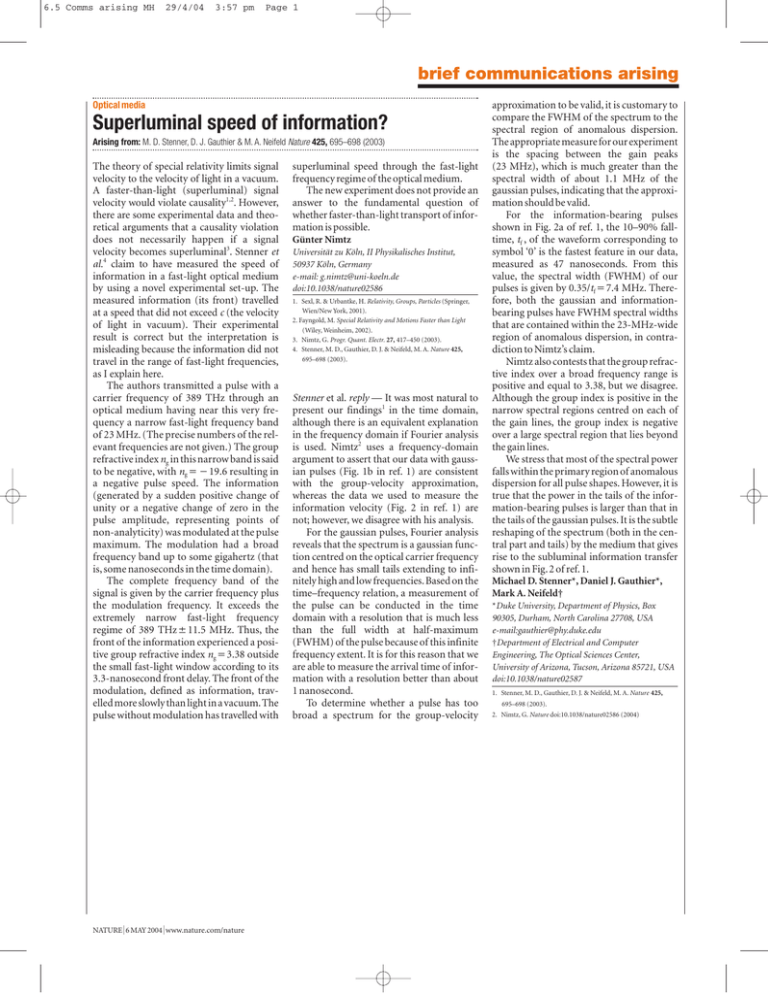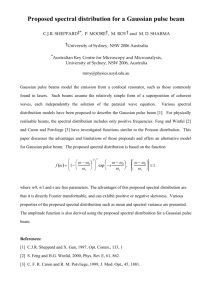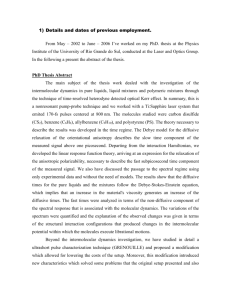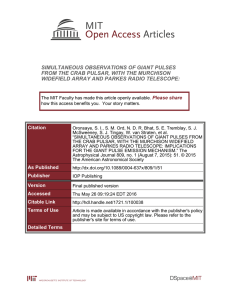The theory of special relativity limits signal
advertisement

6.5 Comms arising MH 29/4/04 3:57 pm Page 1 brief communications arising Optical media Superluminal speed of information? Arising from: M. D. Stenner, D. J. Gauthier & M. A. Neifeld Nature 425, 695–698 (2003) The theory of special relativity limits signal velocity to the velocity of light in a vacuum. A faster-than-light (superluminal) signal velocity would violate causality1,2. However, there are some experimental data and theoretical arguments that a causality violation does not necessarily happen if a signal velocity becomes superluminal3. Stenner et al.4 claim to have measured the speed of information in a fast-light optical medium by using a novel experimental set-up. The measured information (its front) travelled at a speed that did not exceed c (the velocity of light in vacuum). Their experimental result is correct but the interpretation is misleading because the information did not travel in the range of fast-light frequencies, as I explain here. The authors transmitted a pulse with a carrier frequency of 389 THz through an optical medium having near this very frequency a narrow fast-light frequency band of 23 MHz. (The precise numbers of the relevant frequencies are not given.) The group refractive index ng in this narrow band is said to be negative, with ng19.6 resulting in a negative pulse speed. The information (generated by a sudden positive change of unity or a negative change of zero in the pulse amplitude, representing points of non-analyticity) was modulated at the pulse maximum. The modulation had a broad frequency band up to some gigahertz (that is, some nanoseconds in the time domain). The complete frequency band of the signal is given by the carrier frequency plus the modulation frequency. It exceeds the extremely narrow fast-light frequency regime of 389 THz11.5 MHz. Thus, the front of the information experienced a positive group refractive index ng3.38 outside the small fast-light window according to its 3.3-nanosecond front delay. The front of the modulation, defined as information, travelled more slowly than light in a vacuum.The pulse without modulation has travelled with NATURE | 6 MAY 2004 | www.nature.com/nature superluminal speed through the fast-light frequency regime of the optical medium. The new experiment does not provide an answer to the fundamental question of whether faster-than-light transport of information is possible. Günter Nimtz Universität zu Köln, II Physikalisches Institut, 50937 Köln, Germany e-mail: g.nimtz@uni-koeln.de doi:10.1038/nature02586 1. Sexl, R. & Urbantke, H. Relativity, Groups, Particles (Springer, Wien/New York, 2001). 2. Fayngold, M. Special Relativity and Motions Faster than Light (Wiley, Weinheim, 2002). 3. Nimtz, G. Progr. Quant. Electr. 27, 417–450 (2003). 4. Stenner, M. D., Gauthier, D. J. & Neifeld, M. A. Nature 425, 695–698 (2003). Stenner et al. reply — It was most natural to present our findings1 in the time domain, although there is an equivalent explanation in the frequency domain if Fourier analysis is used. Nimtz2 uses a frequency-domain argument to assert that our data with gaussian pulses (Fig. 1b in ref. 1) are consistent with the group-velocity approximation, whereas the data we used to measure the information velocity (Fig. 2 in ref. 1) are not; however, we disagree with his analysis. For the gaussian pulses, Fourier analysis reveals that the spectrum is a gaussian function centred on the optical carrier frequency and hence has small tails extending to infinitely high and low frequencies. Based on the time–frequency relation, a measurement of the pulse can be conducted in the time domain with a resolution that is much less than the full width at half-maximum (FWHM) of the pulse because of this infinite frequency extent. It is for this reason that we are able to measure the arrival time of information with a resolution better than about 1 nanosecond. To determine whether a pulse has too broad a spectrum for the group-velocity approximation to be valid, it is customary to compare the FWHM of the spectrum to the spectral region of anomalous dispersion. The appropriate measure for our experiment is the spacing between the gain peaks (23 MHz), which is much greater than the spectral width of about 1.1 MHz of the gaussian pulses, indicating that the approximation should be valid. For the information-bearing pulses shown in Fig. 2a of ref. 1, the 10–90% falltime, tf , of the waveform corresponding to symbol ‘0’ is the fastest feature in our data, measured as 47 nanoseconds. From this value, the spectral width (FWHM) of our pulses is given by 0.35/tf7.4 MHz. Therefore, both the gaussian and informationbearing pulses have FWHM spectral widths that are contained within the 23-MHz-wide region of anomalous dispersion, in contradiction to Nimtz’s claim. Nimtz also contests that the group refractive index over a broad frequency range is positive and equal to 3.38, but we disagree. Although the group index is positive in the narrow spectral regions centred on each of the gain lines, the group index is negative over a large spectral region that lies beyond the gain lines. We stress that most of the spectral power falls within the primary region of anomalous dispersion for all pulse shapes. However, it is true that the power in the tails of the information-bearing pulses is larger than that in the tails of the gaussian pulses. It is the subtle reshaping of the spectrum (both in the central part and tails) by the medium that gives rise to the subluminal information transfer shown in Fig. 2 of ref. 1. Michael D. Stenner*, Daniel J. Gauthier*, Mark A. Neifeld† *Duke University, Department of Physics, Box 90305, Durham, North Carolina 27708, USA e-mail:gauthier@phy.duke.edu †Department of Electrical and Computer Engineering, The Optical Sciences Center, University of Arizona, Tucson, Arizona 85721, USA doi:10.1038/nature02587 1. Stenner, M. D., Gauthier, D. J. & Neifeld, M. A. Nature 425, 695–698 (2003). 2. Nimtz, G. Nature doi:10.1038/nature02586 (2004)





